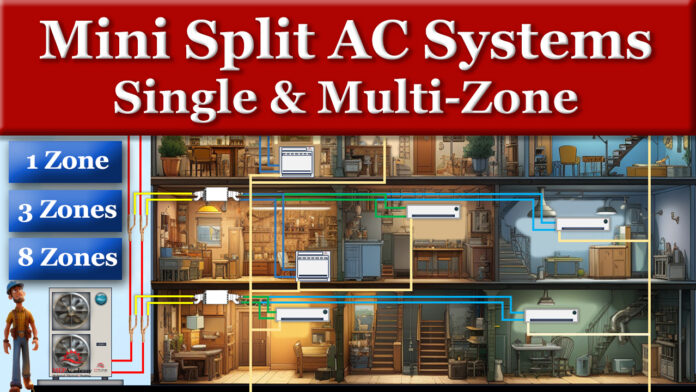We’ll cover single and multi-zone split systems air conditioners and the requirements for piping, electrical, and controls. We’ll show you three different system configurations using a single zone layout, and two different multi zone layouts. There are many different styles of ductless indoor units that we’ll present in this article.
If you prefer to watch the Video of this presentation, then scroll to the bottom or click on the following link. Mini Split Air Conditioners
Single Zone Air Conditioner
The use of a single zone air conditioner is good for one room. The single zone mini split system has two main components. One is the condenser which will be located outdoors on a pad or attached to the wall with a bracket, and the other one of many different indoor fan coils.
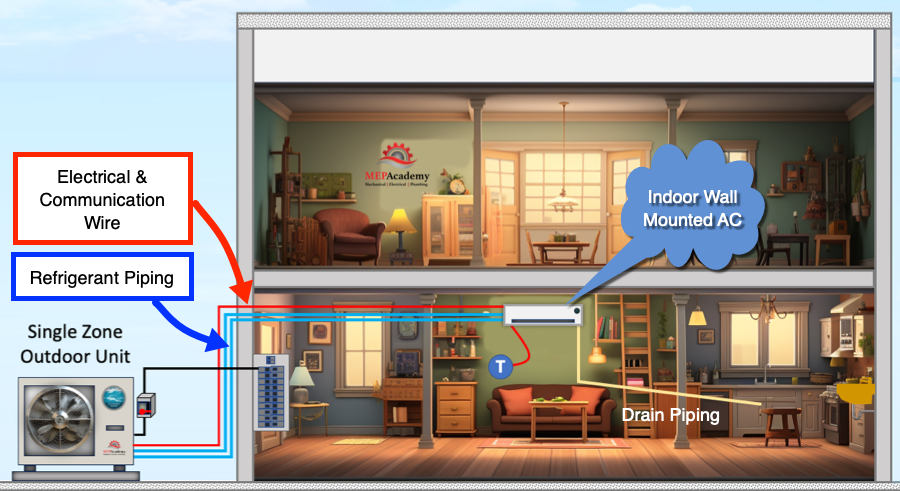
Here we show a wall mounted indoor fan coil which houses the evaporator, fan, and filter. The indoor unit attaches to the wall using a bracket that comes with the unit. Just locate a stud in the wall to mount the bracket for proper support of the unit.
Refrigerant Piping
Insulated copper line sets will be installed from the outdoor unit to the indoor fan coil. There are some line sets that come per-charged with refrigerant. They work for some applications where the distance is 25 feet or less between the outdoor and indoor unit. If a line set doesn’t work then standard lengths of ACR refrigerant piping will need to be installed. This could involve cutting pipe to length, possibly brazing at some locations, and/or new flares installed on the ends.

After making the connection between the outdoor and indoor unit, the non-pre-charged refrigerant line set should be pressure tested to ensure no leaks. Next, a vacuum will be pulled on the piping before opening the valve on the outdoor unit. The outdoor unit can hold a predetermined amount of refrigerant based on system capacity.
Checkout These Mini Split Air ConditionersElectrical Power
Electrical power will need to be provided to the outdoor unit through some form of disconnect. There are two options for powering up the indoor fan coil depending on model and make. One is that the outdoor unit can provide the electrical power directly to the indoor unit along with the communication wire, or the indoor unit can be separately connected to a power source.
Condensate
Since the fan coil produces condensate in cooling mode, there needs to be a drainpipe installed to an approved drain receptor like the tailpipe of a sink or to the outdoors. Condensate occurs when moisture in the air condenses when drawn over the cold indoor coil. The indoor fan coil units have the option for a condensate pump. Condensate may need to be pumped upward before connecting with a drainpipe.
If you have more than one zone or room needing air conditioning, then a multi zone air conditioning system is available in various configurations.
Multi Zone Air Conditioner
With a multi zone system you’ll need an outdoor unit with an inverter compressor. That’s a compressor that can vary the volume of refrigerant to match the current load. There are many different styles of indoor fan coils that you can use such as floor mounted, wall mounted, and a ceiling cassette. There are also ducted versions that can be concealed out of view.

Some manufacturers allow up to nine indoor units for every one outdoor unit.
In this example, this multi zone mini split air conditioning system has three zones. As you can see it requires that you run a set of separate copper refrigerant lines for each indoor fan coil. Each zone feeds a different room, and they each have their own controller. Two rooms could be in cooling mode, while the other one is off.
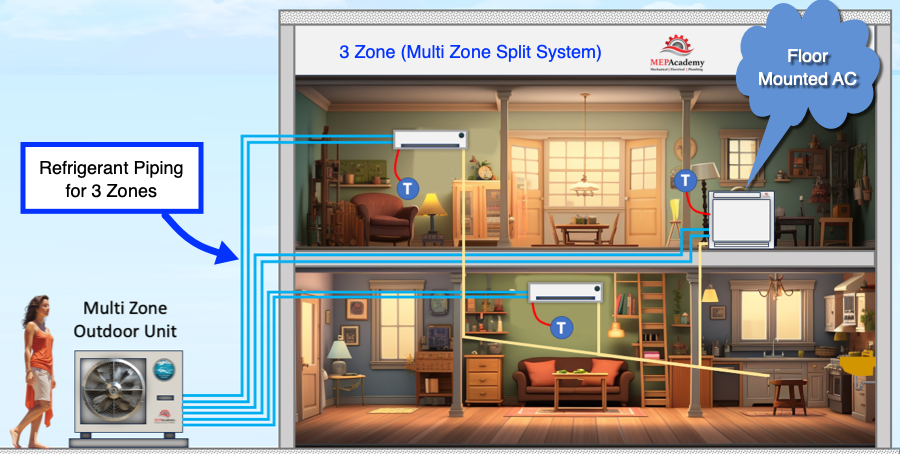
Inverter Compressor
With the inverter compressor the reduced demand is not a problem, as the compressor reduces its flow of refrigerant to meet the demand. The old school central air conditioner will cycle on or off to meet demand. Without an inverter compressor and zoning there was no way to reduce energy usage when demand was reduced.
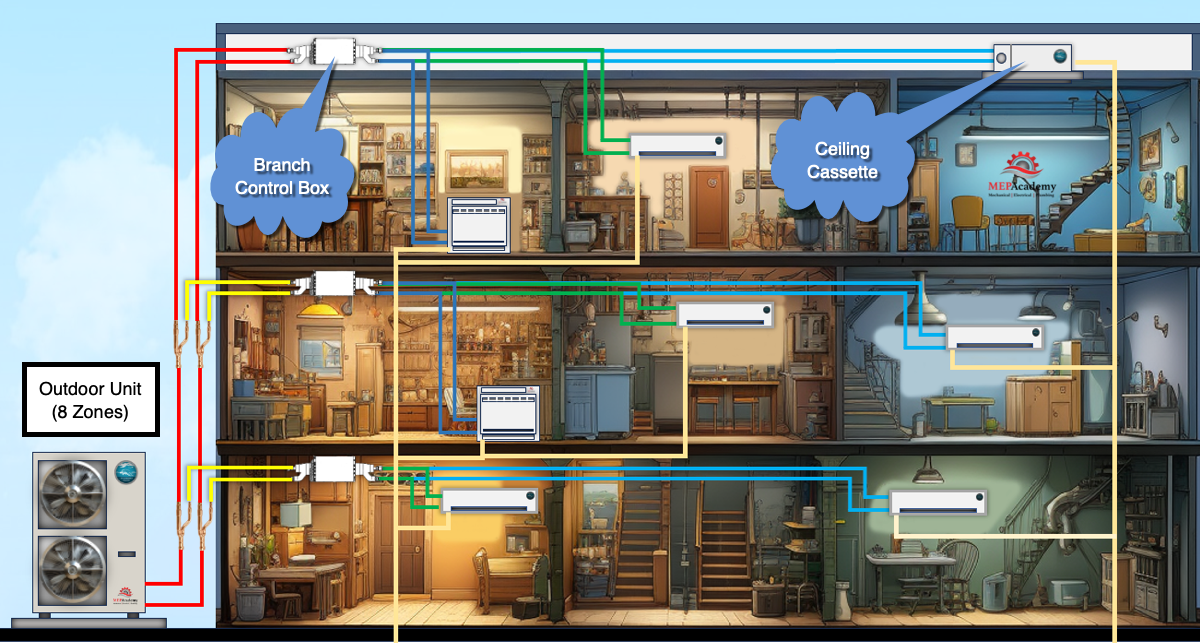
If you need more zones, then there are some manufacturers that allow up to 9 indoor units. Here we show a large home requiring 8 zones. Of course, this is just an example of what’s possible, it’s unlikely this would be the best design for this home.
Refrigerant Piping
Copper tubing carrying the refrigerant will need to be installed starting at the outdoor unit where the compressor is located. The compressor is the pump that pushes and pulls the refrigerant through the system.
The first length of tubing runs from the outdoor unit to a special tee fitting (RefNet) that allows for the refrigerant to go in two directions. The refrigerant piping continues to the next tee fitting, and then to the a branch control box.
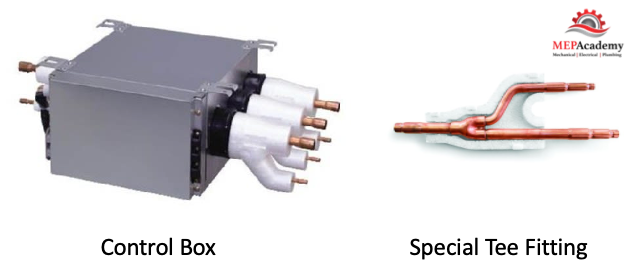
There are two copper tubes entering the control box from the compressor, and two copper tubes leaving for each fan coil unit, one liquid line and the other gas.
A one-ton fan coil will have approximately a 1/4” liquid line and a 3/8” gas line. A two-ton indoor unit may need a 1/4” liquid refrigerant line and a 5/8” refrigerant gas line.
Branch Controller Box
The branch control box on the upper floor of this home has three zones attached to it. So, there will be six copper tubes leaving the box, two for each fan coil.
This system uses a branch control boxes between the outdoor unit and the indoor units. The control box contains electronic expansion valves to control the amount of refrigerant directed to each indoor fan coil based on demand.
This system allows for a maximum of 3 indoor units per control box. A maximum of eight indoor fan coils for one outdoor unit. If you needed more zones, you could add another outdoor unit.
Checkout These Mini Split Air ConditionersElectrical Power
Each component of the system will need electrical power, starting with power coming from the electrical panel to feed the outdoor unit. The power will run to a disconnect switch before entering the compressor. This allows a quick method of disconnecting the power when the unit is being serviced or replaced.
208/230-volt power is run to the first branch control box, then it’s daisy chained to the other two control boxes. The fan coil receives its power directly from the control box.
Summary
These are just three examples of mini split systems, but there are many variations on this. Commercial buildings need to consider ASHRAE 62.1 ventilation during design. See our videos on “Demand Controlled Ventilation” and “Dedicated Outside Air Systems”.
Note that each indoor unit in a ductless mini-split system can be controlled independently, allowing for different temperature settings and personalized comfort in various zones or rooms. This zoning capability is one of the significant advantages of these systems.
Overall, ductless mini-split systems provide efficient and customizable cooling and heating solutions, offering flexibility and energy savings compared to traditional central air conditioning systems. See How Split Systems Work.


